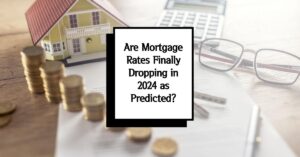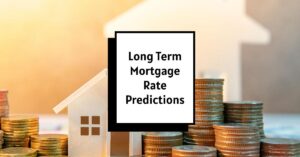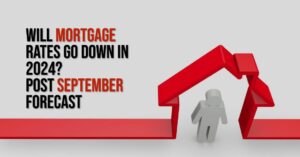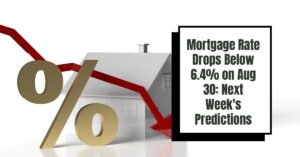
Good News: Mortgage Rates Are Going Down!
You might be wondering, “Are mortgage rates finally dropping?” The answer is a resounding YES! On August 5th, the average interest rate for a 30-year fixed mortgage fell to 6.43%. That's the lowest it's been since April 2023!
This is great news for people who want to buy a house. After more than a year of really high mortgage rates, things are finally looking up. Plus, housing prices have also gone down, making it an even better time to buy.
Why Are Mortgage Rates Dropping Now?
Mortgage rates change based on what investors think the Federal Reserve (the big bank in charge of money) is going to do. Right now, investors believe the Fed is done trying to control inflation (that's when prices for everything go up). Because of this, they think mortgage rates will keep going down slowly for the rest of the year.
The Fed might even lower interest rates next month. However, experts don’t expect mortgage rates to plummet. This is because today’s rates already reflect those anticipated cuts.
What Makes Mortgage Rates Go Up and Down?
A few things affect mortgage rates in the United States:
- Inflation: When prices go up (inflation), mortgage rates usually follow.
- The Federal Reserve: The Fed raises and lowers interest rates to try and keep the economy stable. When they raise rates, mortgage rates often go up too.
- The Economy: A strong economy can sometimes lead to higher mortgage rates, while a weak economy can cause them to fall.
Right now, inflation is still a bit high, and the Fed is trying to get it under control. That's why mortgage rates are still higher than usual.
While some experts think rates might drop a little if inflation keeps cooling down, don't expect a dramatic drop anytime soon. The Fed has hinted that they might keep interest rates high for a while to make sure inflation doesn't come back.
What Will Make Interest Rates Really Drop?
After years of soaring house prices (thanks to low supply and super-low mortgage rates), many potential homebuyers are wondering what signs to watch for.
Of course, a big announcement of lower interest rates is a clear sign. But here are some other things to keep an eye on:
- Fewer Homes Selling: If fewer homes are being bought and sold, it could mean that prices might start to drop, leading to lower rates.
- A Weaker Job Market: When the job market isn't as strong, people tend to spend less money, which can sometimes lead to lower interest rates.
- Cooling Inflation: This is a big one! When inflation goes down, the Federal Reserve is more likely to lower interest rates.
Keep in mind, the Federal Reserve raises interest rates to fight inflation. When inflation eases, they often relax those rate hikes and might even reduce them.
Should I Lock in a Mortgage Rate Today?
Deciding whether to lock in the current mortgage rate is a big decision! It depends on a few things:
- Your Finances: Can you comfortably afford the monthly payments at the current rate?
- Your Risk Tolerance: Are you comfortable knowing your rate is set, or are you okay with the possibility of rates going lower (or higher) in the future?
- What Experts Think: Are economists predicting that rates will go up or down in the coming months?
If you're happy with the current rate and your budget allows for it, locking in now can give you peace of mind. It protects you from the chance of rates going up later, which is still a possibility since things are a bit unpredictable right now.
However, if you think rates might drop soon, or if you're okay with a bit of risk, you could choose to “float” your rate. This means your rate isn’t locked in and could change before you close on your house.
It's always a good idea to talk to a mortgage expert. They can give you personalized advice based on your situation.
When Should I Refinance My Mortgage?
While rates aren't likely to drop massively anytime soon, it's good to know what to watch for if you're thinking about refinancing your home loan.
Refinancing basically means getting a new mortgage to replace your old one. It can save you money if you can get a lower interest rate.
Here's when it might make sense to refinance:
- Rates are Much Lower: Refinancing is usually worth it if the current mortgage rates are at least 0.5% to 1% lower than your existing rate. This could save you a lot of money over the life of your loan.
- Better Credit Score: If your credit score has improved significantly since you got your original mortgage, you might qualify for a lower rate.
- More Equity in Your Home: Equity is the portion of your home that you actually own (not the part you still owe on your mortgage). The more equity you have, the better your chances of getting a lower rate.
- Switching From Adjustable to Fixed Rate: An adjustable-rate mortgage (ARM) can be risky because your interest rate can change. Switching to a fixed-rate mortgage locks in your rate, providing stability.
Before you refinance, calculate your “break-even point.” This is the point at which the money you save from the lower interest rate surpasses the closing costs of getting a new mortgage. If you plan to stay in your home long enough to hit your break-even point, then refinancing might be a smart move!
Final Thoughts
If you're able to buy a house now, this could be a great opportunity. While mortgage rates may continue to drop a little, lower rates also mean more competition from other buyers. This could lead to higher house prices down the line.
Just remember, buying a home is a big decision. Take your time, do your research, and don't be afraid to ask for help from a trusted real estate professional!
ALSO READ:
- Mortgage Interest Rate Predictions After Powell's Jackson Hole Speech
- Will Mortgage Rates Ever Be 3% Again: Future Outlook
- Mortgage Rates Predictions for Next 2 Years
- Mortgage Rate Predictions for Next 5 Years
- Mortgage Rate Predictions for 2025: Expert Forecast
- Prediction: Interest Rates Falling Below 6% Will Explode the Housing Market
- Mortgage Rate Predictions: Why 2% and 3% Rates are Out of Reach
- How Lower Mortgage Rates Can Save You Thousands?
- How to Get a Low Mortgage Interest Rate?
- Will Mortgage Rates Ever Be 4% Again?
- What Will Mortgage Rates Be in 2026: Latest Predictions










